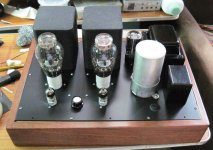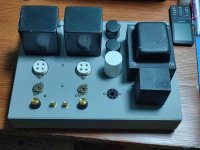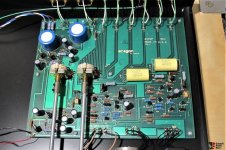yes.......Modern, quality electrolytics will pretty much outlast anything they are installed in, especially if you go with a 105 degree version. Unless, of course, it is in a badly designed system where they are installed in hot areas right next to pass transistors or regulators - unfortunately way too common. The polymers aren't available in higher voltages unfortunately.
It would be nice to have polymers in higher voltages but I don't ever see it happening - the demand just isn't there. I use them a lot and they just about always make an excellent replacement for tantalums. Also standard electrolytics but you have to watch that the low ESR doesn't cause problems.
I agree - as long as the limitations are kept in mind, and you have the space, polypropylene has a lot to offer. I use them a lot since for much of what I do the high IR (or, rather, the low leakage) is very important.
I've got about 150 1675uF 1200V oil filled polypropylene motor run capacitors that, in a case of "if you have 'em use 'em" have been installed more than once in places that something far smaller would do.
They are pretty much a solution in search of a problem for me. The one place they are suited for is in some of the older HP (and other) power supplies that use a SCR pre-regulator... those just hammer the bulk filtering downstream of them. One of the very, very few places that I see the large Compulytic screw terminal capacitors failing.
View attachment 1307396
CBBs are metallized polyprops seen everywhere on ebay. I think "orange drops" used in guitar amps are of this type too. I use them in non-signal applications, like snubbers and in regulators.
The well known orange drops capacitors CDE 715/716p have nothing in common with the cheap cbb capacitors from eBay.
I used to believe this until I swapped a Solen cap for a Wima DC link cap with the same voltage, uf and esr ratings and the bass response in the amp changed drastically. Put a Solen back in and the bass response returned.Power supply capacitors do not sound , good or bad, but if they are too small (such as these) you will have lots of ripple.
This was on a zero feedback SE 300B amp. I even tested the inductance vs frequency looking for a reason and they measured the same. I still can't explain what's happening, and in the past when I have reported this people blew it off as nonsense. I still feel a need to report that because IMHO this idea that all caps sound the same just isn't the case from my personal experience.
A lot of start caps in the U.S.A. are bipolar Al electrolytic , not metal film. According to this article,anything over 20uF is Al - Wiki on start capsMotor start/run capacitors are basically just robust versions of standard film capacitors - just about always with a polypropylene dielectric for the required temperature range. The square ones are of the usual stacked construction while the large can types are rolled and the can filled with oil (typically mineral oil) to enable the required power dissipation level.
All the ones I have seen were encapsulated in black plastic.
We are all listing to our power supply, some of us just don't like to admit it. 🙂I used to believe this until I swapped a Solen cap for a Wima DC link cap with the same voltage, uf and esr ratings and the bass response in the amp changed drastically. Put a Solen back in and the bass response returned.
This was on a zero feedback SE 300B amp. I even tested the inductance vs frequency looking for a reason and they measured the same. I still can't explain what's happening, and in the past when I have reported this people blew it off as nonsense. I still feel a need to report that because IMHO this idea that all caps sound the same just isn't the case from my personal experience.
Could very well be those that can't hear the difference a cap can make in some circumstances.
typo -> for "listing", read "listening".We are all listing to our power supply, some of us just don't like to admit it.
Of course that is almost certainly absolutely correct because a single ended amplifier is effectively "pulsing" current continuously, which is the same charge/recharge cycle as ripple, albeit with a different timing frequency.
Only a properly designed push-pull amplifier can eliminate this "rippling". That can be done because the first stage multiplication inverts the signal and a concertina second stage phase splitter operating point can be chosen to use the same current as the first stage. That means the current simply recirculates around those first two stages and is invariant to the power supply. The remaining stage(s), being push-pull do likewise. Just put in a bias servo to keep this enforced. You thus become invariant to power supply capacitor concerns because you are running at constant current.
kind regards
Marek
And I feel some amp designs are way more sensitive to things like this than others.We are all listing to our power supply, some of us just don't like to admit it. 🙂
Could very well be those that can't hear the difference a cap can make in some circumstances.
I think another way is to have all stages differential and sitting on CCSes (a push-pull stage sitting on a high impedance CCS being akin to a long tail pair). The amp I am currently building is of this sort: 2 stage, input stage LTP IT-coupled to push-pull stage. Both sit on solid-state CCS having very high Z.Just put in a bias servo to keep this enforced. You thus become invariant to power supply capacitor concerns because you are running at constant current.
Okay so out of curiosity I made the experiment. Capacitor on a metal grille to allow air flow around, hair dryer pointed at it and monitoring case temperature with an IR meter. At 20°C the larger section had a capacitance of 14.36uF. After heating to a case temperature of 70°C (the maximum operating temp stated on the cap), capacitance was down to 14.28°C. After cooling the capacitance returned to its room temp value, suggesting the variation wasn't a measuring artifact.Exactly. The polyester has a positive tempco and the polyprop negative.
So that would be a polyprop, and with a pretty good temperature stability as required for mains operation. Despite suggestions as it being not worth the time, I am tempted to try it in my current design. Not enough capacitance for input cap but I have a use-case cut-out for them in my regulators.
The larger section at the output to compensate for regulator inductive-like behavior and the smaller section as the error amplifier feedback capacitor; the common lead being connected to B+.
Last edited:
Interesting indeed! Very nice builds btw 👍very noticeable is the the volumetric efficiency attained over the years
Thanks for actually measuring.
A rare jewel in an era when many go by "opinion" only.
Incredible temperature stability; only 0.56% variation in the "ambient to max rating" range? Wow!
In an industrial, non Audiophile or "Audio grade" part?
Not presented with any overblown salesman verbiage?
Double wow!.👍🏻
A rare jewel in an era when many go by "opinion" only.
Incredible temperature stability; only 0.56% variation in the "ambient to max rating" range? Wow!
In an industrial, non Audiophile or "Audio grade" part?
Not presented with any overblown salesman verbiage?
Double wow!.👍🏻
Can you guys recommend a good film cap from Mouser or Digikey
Here are the 2 film caps I am going to replace with something newer
10 MF 100V
I was thinking Cornell Dubilier 940C
nice review here
https://www.humblehomemadehifi.com/Cap.html
Here are the 2 film caps I am going to replace with something newer
10 MF 100V
I was thinking Cornell Dubilier 940C
nice review here
https://www.humblehomemadehifi.com/Cap.html
Attachments
I've used the black "box" ceiling fan motor run caps in crossovers, they're cheap, easy to mount (some even have a lug with screw hole) and "industrial standards" might well be better than, others...
Agreed. I'm in the process of re-capping electrolytics on my 35 years-old Rega integrated amp, section by section. There are a couple of cap models that have unusual form factors. For the first section I replaced, the only compatible cap available at Digikey or Mouser was an "industrial" series by Vishay. Had no choice but put them in, and they sounded just as good as the fancy "Eurocap" they replaced, with the added bonus of higher temp rating and longer service hours expectancy."industrial standards" might well be better than, others...
As I'm not getting any youger, I want this endeavour to be the last so will replace all caps with high temp/long service life ones and will not shy away from industrial stuff as they usually have better specs in those fields.
- Home
- Amplifiers
- Tubes / Valves
- Metallized Polypropylene or Polyester film Motor run caps for PS filtering


